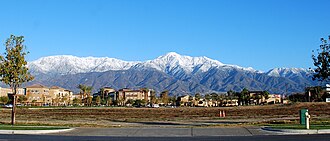Welcome to Rancho Cucamonga, a city with a rich tapestry of history woven into the very fabric of California’s development. Located at the foot of the majestic San Gabriel Mountains, this vibrant city is a testament to human ingenuity and resilience, thriving over centuries through its strategic location and fertile lands.
Our story begins with the Kukamongan Native Americans, who, by 1200 AD, had established a village in this ‘sandy place,’ as the name suggests in the Tongva language. This area became a vital hub for the Tongva people, one of the largest native groups in North America.
Fast forward to the late 1760s, when Spanish explorers, led by Gaspar de Portola, arrived, marking the beginning of significant changes. The land was soon incorporated into the expansive Spanish Mission system, aimed at spreading Christianity and European culture among the native populations. This was part of a broader effort led by Father Junipero Serra and his Franciscan friars.
In 1839, during the era of Mexican rule, the land known as ‘Cucamonga’ was granted to Tubercio Tapia, a spirited Spaniard who left his mark as a merchant and, intriguingly, a smuggler. Tapia saw the potential in the fertile soil and established California’s first winery here, setting the stage for a wine legacy that continues to this day.
The mid-19th century ushered in new ownership under John Rains and his wife. They constructed Casa de Rancho Cucamonga in 1860, which stands today as a historic site on the National Register of Historic Places. This period saw the town’s prosperity grow, driven by agriculture, including olives, peaches, and vineyards, as well as the construction of irrigation systems by Chinese laborers in 1887.
The arrival of the Santa Fe Railroad around the same time transformed Rancho Cucamonga into a bustling transport hub. The railroad, alongside the Pacific Electric Railway introduced in 1913, played crucial roles in the area’s agricultural boom by facilitating the movement of crops.
Rancho Cucamonga’s journey to modernity took a significant turn in 1977 when the communities of Alta Loma, Cucamonga, and Etiwanda joined forces to form the city as we know it today. This unification marked a new chapter of growth and development.
Today, Rancho Cucamonga stands as a testament to its storied past, with landmarks like Our Lady of Mt. Carmel and the Chinatown House reminding us of the diverse cultural influences that have shaped this city. From its native roots to its role in California’s wine industry, Rancho Cucamonga remains a vibrant community, celebrating its heritage while looking toward the future.
As you explore or imagine walking through this city, remember the tales of the Kukamongan people, the entrepreneurial spirit of Tubercio Tapia, and the tireless laborers who built the foundations of a thriving community. Rancho Cucamonga is more than just a place; it’s a living narrative of history and culture, inviting you to become a part of its ongoing story.





